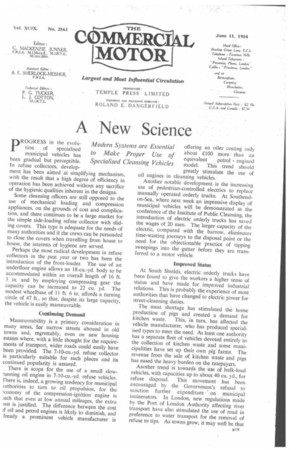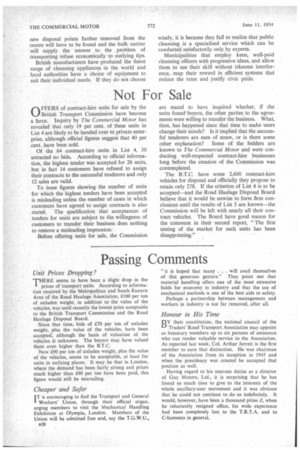A New Science
Page 53

Page 54

If you've noticed an error in this article please click here to report it so we can fix it.
Modern Systems are Essential to Make Proper Use of Specialised Cleansing Vehicles pROGRESS in the evolution of specialised municipal vehicles has been gradual but perceptible. In refuse collectors, development has been aimed at simplifying mechanism, with the result that a high degree of efficiency in operation has been achieved without any sacrifice of the hygienic qualities inherent in the designs.
Some cleansing officers are still opposed to the use of mechanical loading and compression appliances, on the grounds of cost and complication, and there continues to be a large market for the simple side-loading refuse collector with sliding covers. This type is adequate for the needs of many authorities and if the crews can be persuaded to close the covers when travelling from house to house, the interests of hygiene are served.
Perhaps the most radical development in refuse collectors in the past year or two has been the introduction of the front-loader. The use of an underfloor engine allows an 18-cu.-yd. body to be accommodated within an overall length of 16 ft. 3 in. and by employing compressing gear the capacity can be increased to 22 cu. yd. The modest wheelbase of 11 ft. 6 in. affords a turning circle of 47 ft., so that, despite its large capacity, the vehicle is easily manoeuvrable.
Continuing Demand Manceuvrability is a primary consideration in many areas, for narrow streets abound in old towns and, regrettably, even on new housing estates where, with a little thought for the requirements of transport, wider roads could easily have been provided. The 7-10-cu.-yd. refuse collector is particularly suitable for such places and its continued popularity is assured.
There is scope for the use of a small slowrunning oil engine in 7-10-cu.-yd. refuse vehicles. There is, indeed, a growing tendency for municipal iuthorities to turn to oil propulsion, for the economy of the compression-ignition engine is uch that even at low annual mileages, the extra .ost is justified. The difference between the cost sf oil and petrol engines is likely to diminish, and lready a prominent vehicle manufacturer is offering an oiler costing only about £100 more than an equivalent petrol engined model. This trend should greatly stimulate the use of oil engines in cleansing vehicles.
Another notable development is the increasing use of pedestrian-controlled electrics to replace manually operated orderly trucks. At Southendon-Sea, where next week an impressive display of municipal vehicles will be demonstrated at the conference of the Institute of Public Cleansing, the introduction of electric orderly trucks has saved the wages of 20 men. The larger capacity of the electric, compared with the barrow, eliminates time-wasting journeys to the disposal point or the need for the objectionable practice of tipping sweepings into the gutter before they are transferred to a motor vehicle.
Improved Status At South Shields, electric orderly trucks have been found to give the workers a higher sense of status and have made for improved industrial relations. This is probably the experience of most authorities that have changed to electric power for street-cleansing duties.
The meat shortage has stimulated the home production of pigs and created a demand for kitchen waste. This, in turn, has affected the vehicle manufacturer, who has produced specialised types to meet the need. At least one authority has a separate fleet of vehicles devoted entirely to the collection of kitchen waste and some municipalities have set up their own pig farms. The revenue from the sale of kitchen waste and pigs has eased the heavy burden on the ratepayers.
Another trend is towards the use of bulk-load vehicles, with capacities up to about 40 cu. yd., for refuse disposal. This movement has been encouraged by the Government's refusal to sanction further expenditure on municipal incinerators. In London, new regulations made by the Port of London Authority affecting river transport have also stimulated the use of road in preference to water transport for the removal of refuse to tips. As towns grow, it may well be that new disposal points farther removed from the centre will have to be found and the bulk carrier will supply the answer to the problem of transporting refuse economically to outlying tips.
British manufacturers have produced the finest range of cleansing appliances in the world and local authorities have a choice of equipment to suit their individual needs. If they do not choose wisely, it is because they fail to realize that public cleansing is a specialised service which can be conducted satisfactorily only by experts.
Municipalities that employ keen, well-paid cleansing officers with progressive ideas, and allow them to use their skill without irksome interference, reap their reward in efficient systems that reduce the rates and justify civic pride.




















































































































































